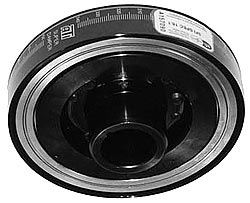
All of the above are signs of unchecked crankshaft
harmonic vibration in a race engine. Usually,
the above symptoms go hand in hand with a non-functioning
damper on the nose of the crank or when a simple
aluminum hub is installed in place of damper.
And one more thing to consider before we go
on to other things: that lump (the damper) that
hangs off the nose of your engine is not a balancer.
In truth, it balances nothing. The main purpose
of that big hunk of metal out front is to absorb
harmonics. Harmonics and balance are two decidedly
different things.
OPERATIONAL RANGE
The operating range of an engine along with
the speed at which an engine accelerates can
have a profound effect upon the damper requirements.
Some dampers are "tuned" to operate at a specific
RPM level. That's fine for an engine that runs
at a constant or relatively constant speed (a
good example is a diesel highway tractor with
a dozen or more forward gears), but if the engine
is accelerating and decelerating over a wide
RPM range (as in a drag race application), then
frequency tuning becomes troublesome.
Case-in-point is a widely publicized test run
by Katech for General Motors. Four aftermarket
dampers were tested on a 427 cubic inch small
block (4.125" bore X 4.00" stroke). From 3,112
RPM to approximately 6,500 RPM, none of the
dampers twisted the crankshaft more than 0.6
degrees. But after 6,500 RPM, the test proved
revealing: crankshaft twist increased by a considerable
margin in three of the dampers. At 7,893 RPM,
the one damper showed 2.0 degrees of crank twist.
Another showed 1.7 degrees of twist. Yet another
showed approximately 1.25 degrees of twist.
Finally, the last damper, which was an ATI model
similar to the assembly shown in the accompanying
photos showed 0.28 degrees of crankshaft twist.
The point in outlining the above exercise isn't
to compare dampers. Instead, it goes to show
that crankshafts definitely do migrate. They're
not immovable objects. They do twist. And in
some cases, more than others.
WHAT MAKES A DAMPER TICK?
What makes a damper such as this ATI model
tick? Basically, it's a complete re-think of
the proven elastomer damper configuration. Elastomer
dampers have been in use for many years by Detroit.
These designs are good at what they do, but
conventional single strip elastomer dampers
are, for the most part, not rebuildable. Typically,
a stock damper has an inertia weight with a
rubber insulator pressed to the crank hub. By
nature of the design, this means that there
is a possibility of the ring moving in relation
to the hub. If the weight doesn't fly off (that's
why SFI-approved dampers were mandated in the
first place by the major drag race sanctioning
bodies), there is still a chance that the timing
marks will be lost in relation to the crank
key way.
According to ATI, during the manufacturing
process of an OE damper, it is impossible to
maintain the concentricity of the inertial ring
to the hub. The ring must be machined after
it is pressed to the hub then balanced after
machining. When it comes loose, imbalance can
occur. In contrast, the ATI Super Damper employs
a combination of 70-durometer o-rings and a
unique, full-captured inertia ring to dampen
harmful crankshaft vibrations. This design configuration
allows the damper to actually function as two
dampers in one given diameter. This accounts
for the absorption of twist over such a large
RPM range (racers have used the Super Damper
in RPM ranges exceeding 9,000 RPM) -- especially
when the engine is accelerated or decelerated.
 |
The ATI damper is
an elastomer configuration (just like many
OEM dampers), but there's a "twist". The
elastomer is physically captured in the
design. It also relies upon a series of
70-durometer o-rings to help control crankshaft
vibrations. The unique design allows the
damper to actually function as two dampers
in one. Testing by General Motors has shown
that the ATI damper is very efficient when
it comes to displacing crankshaft twist.
By the way, this 7.0-inch configuration
only weighs 8.95 pounds, ready to race and
that includes approximately 4.5 pounds of
inertia weight. |

|